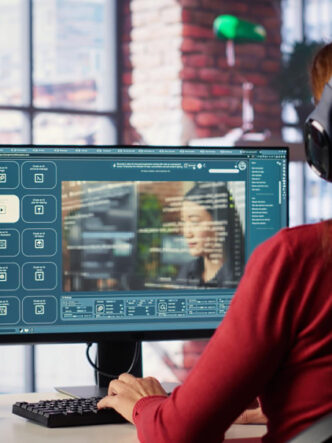If you want to optimize e-learning you must collect, measure, and analyze data. This helps you to identify patterns and trends and understand more about how learners interact with your course material. Insights from e-learning analytics can help you to make data-driven decisions. This can save you time and money in the long run by making your e-learning course content more effective and relevant. Learners will experience more personalized learning which boosts their chances of success.
One of the most effective ways to reach learners today is with the use of video content. Videos cater to different learning styles and you can use many different types of videos for e-learning.
This may include live streaming and video-on-demand (VOD). When using video for e-learning, video analytics provide a way to find out how learners engage with your videos.

What to track: Completion rates, drop-off points, engagement
Knowing which analytics to track and how to use the data to evaluate e-learning is critical. Video analytics for e-learning can help you track metrics such as completion rates, drop-off points, engagement, etc.
Course engagement: Completion rates may not always align with engagement levels. Learners may successfully complete a course but without much engagement during the process.
Device types: When you track e-learning engagement, you may need to address certain technical issues. Using analytics can uncover what devices learners use most to access learning materials. If the video platform you use isn’t mobile responsive, learners will have difficulty watching videos on their mobile devices.
Learner progress: Video analytics can help to track learner progress. Are they behind or are they moving ahead of other learners? A learner that is far behind could be finding the course challenging or may have lost interest. If analytics show that a number of students have difficulty with a particular section of a course, you may have to rework that section.
Learner satisfaction: Polls and surveys can help to gauge learner satisfaction. They can quickly reveal what learners find works well and what may need improvement.
Session times: You can use session time information to determine the optimum length of videos. For example, if you estimate the time it takes to complete a course video as 10 minutes but learners spend 20 minutes, you may have to consider adjusting its length.
Drop off rates: If learners drop off videos early, you need to analyze why this is happening. You may have to shorten a video that’s too long or make content more relevant.
Cincopa private video hosting platform offers advanced video analytics. You can receive in-depth insights into learner behavior and content performance. You can measure engagement and KPIs with actionable insights.
A live feed offers detailed information about every learner who watches a video, including engagement rate. A video heatmap shows you exactly how learners interact with videos and whether they pause, skip, or rewatch content.
A dashboard shows video stats within a specific timeframe. Data in graph form helps you to understand how video stats change dynamically.
A viewer screen provides information about each user, such as location, viewing time, average engagement, IP address, platform, and first and last view dates.

How analytics can improve training content
Understanding student’s needs, behaviors and preferences around e-learning can inform your strategic planning and decision-making. You can address learning issues ahead of time and provide the right resources at the right time.
Personalization
Understanding how students learn allows you to personalize training content. When you can analyze performance and behavior, you have the insights you need to tailor your courses. If certain parts of videos do not appear to engage students as much as others, you need to investigate further.
Perhaps the information is too difficult or not engaging enough. You can support students who struggle and offer them extra resources. You can offer more advanced material to students who are ready for it. Personalization can increase their motivation and retention.
Course adjustments
If data shows that students often skip a particular video, it may indicate that they don’t see it as valuable. You may decide to modify it or replace it with a more engaging video. On the Cincopa platform, editing or replacing videos is easy.
Feedback loops
Creating feedback loops is an essential part of improving e-learning. Analytics help to track feedback via surveys, discussion boards, video messaging, etc. Qualitative data like this helps to complement quantitative data and provides a more comprehensive view of the entire student experience.
Actively acquiring and responding to feedback creates a more dynamic learning environment. It can keep evolving to meet the changing needs of learners. A Gallup study of over 65,600 employees found that companies with strength-related feedback had a 14.3% lower turnover than those who didn’t offer feedback.
Real-time feedback to enhance learning experiences
Feedback is one of the most powerful influences on learning. Most employees today agree that they would appreciate more feedback. Real-time feedback is information they receive in context and ‘on demand’ as a response to their actions.
Timely and relevant
Real-time feedback is timely and relevant as students can absorb it and act on it while it’s contextual to their present learning. They receive help at their point of need. When feedback is delayed it is often ineffective. It may not relate to their current learning and they forget it because they don’t apply it.
Feedback in a vacuum has no effect. It must be relevant within the learning context. This is why bite-sized video content is so successful. It is easier to digest, understand, and apply. On the Cincopa platform, you can create bite-sized videos that help with retention of information.
Faster and more effective learning
Students learn faster and more effectively when they are clear about what they know and what they still need to master. Instant feedback reinforces why they were right and affirms their competence.
Correcting their mistakes in real time shows them why they were wrong and makes learning active rather than passive. Affirming or correcting their input allows students to progress and makes learning more autonomous and self-directed.
Intrinsic motivation and knowledge retention
Real-time feedback can improve intrinsic motivation. This is motivation that comes from within rather than from an external stimulus like money. With this type of motivation to learn, knowledge retention improves. Immediate action on feedback creates stronger mental ties to the material.
More accessibility and interaction
By identifying learners with disabilities or other difficulties, you can offer additional resources and support. The Cincopa platform offers the opportunity to add interactive elements to videos. For example, adding subtitles can help foreign language speakers to learn.
Conclusion
By leveraging video analytics, you can support strategic alignment with your business goals and substantiate your return on investment (ROI). You can use data insights to improve and personalize the e-learning process. Learners can receive real-time feedback about their progress which is crucial to their success. On Cincopa’s home page, you can find out more about its features such as its video analytics. Using them allows you to make continuous improvements to your videos so they stay effective and relevant.
Start a free trial ….








